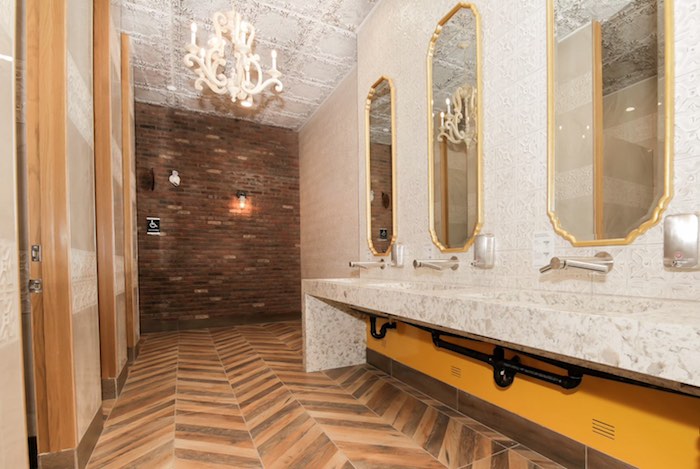Alberta
Red Deer Restroom just might be the loveliest lavatory in Canada!

Technically it’s in Gasoline Alley which means Red Deer County can also lay claim to this magnificent water closet at the Sweet Market Esso Station on the city’s south edge. Canada’s best restroom contest has named the top 5 finalists and three incredible Alberta biffies are on the list!
Clearly the Sweet Market Esso’s palatial potties are the most beautiful, but that does not make it the clear cut winner. The Sweet Market will need Central Albertans to rally behind this luscious lavatory if they’re going to win. This is a voting contest so you can do your part to make sure the Sweet Market Esso ‘wipes up’ the competition.
Just look at this beauty! Voting information is below.





News Release from Cintas Canada
The Sweet Market Esso Station in Red Deer, AB is a finalist in the 2021 Canada’s Best Restroom contest!
The five finalists include:
- Toronto Zoo – Toronto, ON
- Surrey Park – Surrey, BC
- Sweet Market Esso Station – Red Deer, AB
- The ROOFTOP – Calgary, AB
- Borden Park – Edmonton, AB
The public can submit multiple votes for the Toronto Zoo and the other four finalists now through July 9 at bestrestroom.com/Canada.
The facility that receives the most votes will win $2,500 in facility services from Cintas to help maintain their award-winning washrooms.
Cintas Canada Unveils Five Finalists in the 2021 Canada’s Best Restroom Contest
The polls are open now through July 9
Cintas Canada, Ltd. invites the public to vote for the five finalists in the 2021 Canada’s Best Restroom contest! The polls are open now through July 9 at bestrestroom.com/Canada. The facility that receives the most votes will win $2,500 in facility services from Cintas to help maintain their award-winning washrooms.
Cintas’ nationwide contest highlights businesses that have invested in developing and maintaining exceptional washrooms. “These five facilities demonstrate a commitment to prioritizing hygiene and customer service – especially as cleanliness is so important right now – combined with creativity and whimsy not usually seen in washrooms,” said Candice Raynsford, Marketing Manager, Cintas Canada.
Nominees for this year’s contest were judged on five criteria: cleanliness, visual appeal, innovation, functionality and unique design elements. The five finalists include:
Toronto Zoo – Toronto, ON


Designed with the Toronto Zoo’s mission of connecting people, animals and conservation science to fight extinction in mind, the new washrooms in the Zoo’s Tundra Trek feature iconic Canadian species. The design draws on inspiration from our natural world for its fresh yet familiar atmosphere. From the cool blue mosaic walls that represent the calm transition of horizon to sky, to the dark and dramatic overhead features that represent the vast night sky across the tundra, no detail is too small. Each handwashing unit features a hands-free faucet, soap dispenser and hand dryer. The trough-style sink eliminates water splashing on the floor and includes hooks on the outside of the counter to hang a purse, backpack or coat. This state-of-the-art facility modernizes the Toronto Zoo’s guest experience in a visually stunning way.
Surrey Park – Surrey, BC


The intent for the park washroom was to create a playful, durable, safe facility that works well within the City of Surrey’s park contexts. The washroom was designed to be universally accessible, hands-free with no-touch fixtures and configured for solar power. It also features public art panels on all four sides of the structure. The design employs a distinct form, strong colours and unique use of materials.
Sweet Market Esso Station – Red Deer, AB

The washrooms at Sweet Market Esso boast decorative high-end tiles and five-star finishes, giving the restrooms a classy feel, mimicking a fancy hotel suite in Italy rather than a convenience store restroom. These washrooms are always a topic of customer conversation in the store where selfies take center stage. The constant comments regarding the awe of it all – plus the extreme cleanliness – are great reminders of the sheer elegance and grandeur these restrooms provide for the customer.
The ROOFTOP – Calgary, AB


The ROOFTOP restaurant is a unique “weather managed” outdoor patio experience located in downtown Calgary. The adjacent indoor washrooms were designed to be inclusive, engaging and distinctively unique. As you enter “The Alley” you are greeted by a life-sized bobblehead re-imagined as your personal concierge. Walk in to immerse yourself in the funky and fun graffiti wallpaper sections taken largely from the “John Lennon Peace Wall” originally created in Prague. Elements of surprise abound throughout these unusual washrooms, including the porta-potty door in the “Mostly Men” area and hidden selfie walls.
Borden Park – Edmonton, AB

Designed by gh3, the washrooms are at the core of the single-level pavilion surrounded by highly reflective glass. An integrated approach to environmental sustainability is evident in the choice of materials: wood, concrete and glass were selected for their durability, permanence and timelessness. The washroom features hands-free elements to reduce germs and a stainless-steel trough-style sink that prevents water splashing on the floor. The sleek washroom stands as a striking improvement on the typical concrete options, and a sign of outstanding design to come.
For contest updates, fun facts and washroom trivia, “Like” Canada’s Best Restroom on Facebook at www.Facebook.com/CanadasBestRestroom.
Alberta
Alberta takes big step towards shorter wait times and higher quality health care

From the Fraser Institute
On Monday, the Smith government announced that beginning next year it will change the way it funds surgeries in Alberta. This is a big step towards unlocking the ability of Alberta’s health-care system to provide more, better and faster services for the same or possibly fewer dollars.
To understand the significance of this change, you must understand the consequences of the current (and outdated) approach.
Currently, the Alberta government pays a lump sum of money to hospitals each year. Consequently, hospitals perceive patients as a drain on their budgets. From the hospital’s perspective, there’s little financial incentive to serve more patients, operate more efficiently and provide superior quality services.
Consider what would happen if your local grocery store received a giant bag of money each year to feed people. The number of items would quickly decline to whatever was most convenient for the store to provide. (Have a favourite cereal? Too bad.) Store hours would become less convenient for customers, alongside a general decline in overall service. This type of grocery store, like an Alberta hospital, is actually financially better off (that is, it saves money) if you go elsewhere.
The Smith government plans to flip this entire system on its head, to the benefit of patients and taxpayers. Instead of handing out bags of money each year to providers, the new system—known as “activity-based funding”—will pay health-care providers for each patient they treat, based on the patient’s particular condition and important factors that may add complexity or cost to their care.
This turns patients from a drain on budgets into a source of additional revenue. The result, as has been demonstrated in other universal health-care systems worldwide, is more services delivered using existing health-care infrastructure, lower wait times, improved quality of care, improved access to medical technologies, and less waste.
In other words, Albertans will receive far better value from their health-care system, which is currently among the most expensive in the world. And relief can’t come soon enough—for example, last year in Alberta the median wait time for orthopedic surgeries including hip and knee replacements was 66.8 weeks.
The naysayers argue this approach will undermine the province’s universal system and hurt patients. But by allowing a spectrum of providers to compete for the delivery of quality care, Alberta will follow the lead of other more successful universal health-care systems in countries such as Australia, Germany, the Netherlands and Switzerland and create greater accountability for hospitals and other health-care providers. Taxpayers will get a much better picture of what they’re paying for and how much they pay.
Again, Alberta is not exploring an untested policy. Almost every other developed country with universal health care uses some form of “activity-based funding” for hospital and surgical care. And remember, we already spend more on health care than our counterparts in nearly all of these countries yet endure longer wait times and poorer access to services generally, in part because of how we pay for surgical care.
While the devil is always in the details, and while it’s still possible for the Alberta government to get this wrong, Monday’s announcement is a big step in the right direction. A funding model that puts patients first will get Albertans more of the high-quality health care they already pay for in a timelier fashion. And provide to other provinces an example of bold health-care reform.
Alberta
Alberta’s embrace of activity-based funding is great news for patients

 From the Montreal Economic Institute
From the Montreal Economic Institute
Alberta’s move to fund acute care services through activity-based funding follows best practices internationally, points out an MEI researcher following an announcement made by Premier Danielle Smith earlier today.
“For too long, the way hospitals were funded in Alberta incentivized treating fewer patients, contributing to our long wait times,” explains Krystle Wittevrongel, director of research at the MEI. “International experience has shown that, with the proper funding models in place, health systems become more efficient to the benefit of patients.”
Currently, Alberta’s hospitals are financed under a system called “global budgeting.” This involves allocating a pre-set amount of funding to pay for a specific number of services based on previous years’ budgets.
Under the government’s newly proposed funding system, hospitals receive a fixed payment for each treatment delivered.
An Economic Note published by the MEI last year showed that Quebec’s gradual adoption of activity-based funding led to higher productivity and lower costs in the province’s health system.
Notably, the province observed that the per-procedure cost of MRIs fell by four per cent as the number of procedures performed increased by 22 per cent.
In the radiology and oncology sector, it observed productivity increases of 26 per cent while procedure costs decreased by seven per cent.
“Being able to perform more surgeries, at lower costs, and within shorter timelines is exactly what Alberta’s patients need, and Premier Smith understands that,” continued Mrs. Wittevrongel. “Today’s announcement is a good first step, and we look forward to seeing a successful roll-out once appropriate funding levels per procedure are set.”
The governments expects to roll-out this new funding model for select procedures starting in 2026.
* * *
The MEI is an independent public policy think tank with offices in Montreal, Ottawa, and Calgary. Through its publications, media appearances, and advisory services to policymakers, the MEI stimulates public policy debate and reforms based on sound economics and entrepreneurship.
-

 Also Interesting2 days ago
Also Interesting2 days agoMortgage Mayhem: How Rising Interest Rates Are Squeezing Alberta Homeowners
-

 2025 Federal Election2 days ago
2025 Federal Election2 days agoConservative Party urges investigation into Carney plan to spend $1 billion on heat pumps
-

 Also Interesting2 days ago
Also Interesting2 days agoExploring Wildrobin Technological Advancements in Live Dealer Games
-

 2025 Federal Election2 days ago
2025 Federal Election2 days agoCommunist China helped boost Mark Carney’s image on social media, election watchdog reports
-

 2025 Federal Election2 days ago
2025 Federal Election2 days agoFifty Shades of Mark Carney
-

 2025 Federal Election2 days ago
2025 Federal Election2 days agoCorporate Media Isn’t Reporting on Foreign Interference—It’s Covering for It
-

 Business1 day ago
Business1 day agoStocks soar after Trump suspends tariffs
-

 Justice2 days ago
Justice2 days agoCanadian government sued for forcing women to share spaces with ‘transgender’ male prisoners





